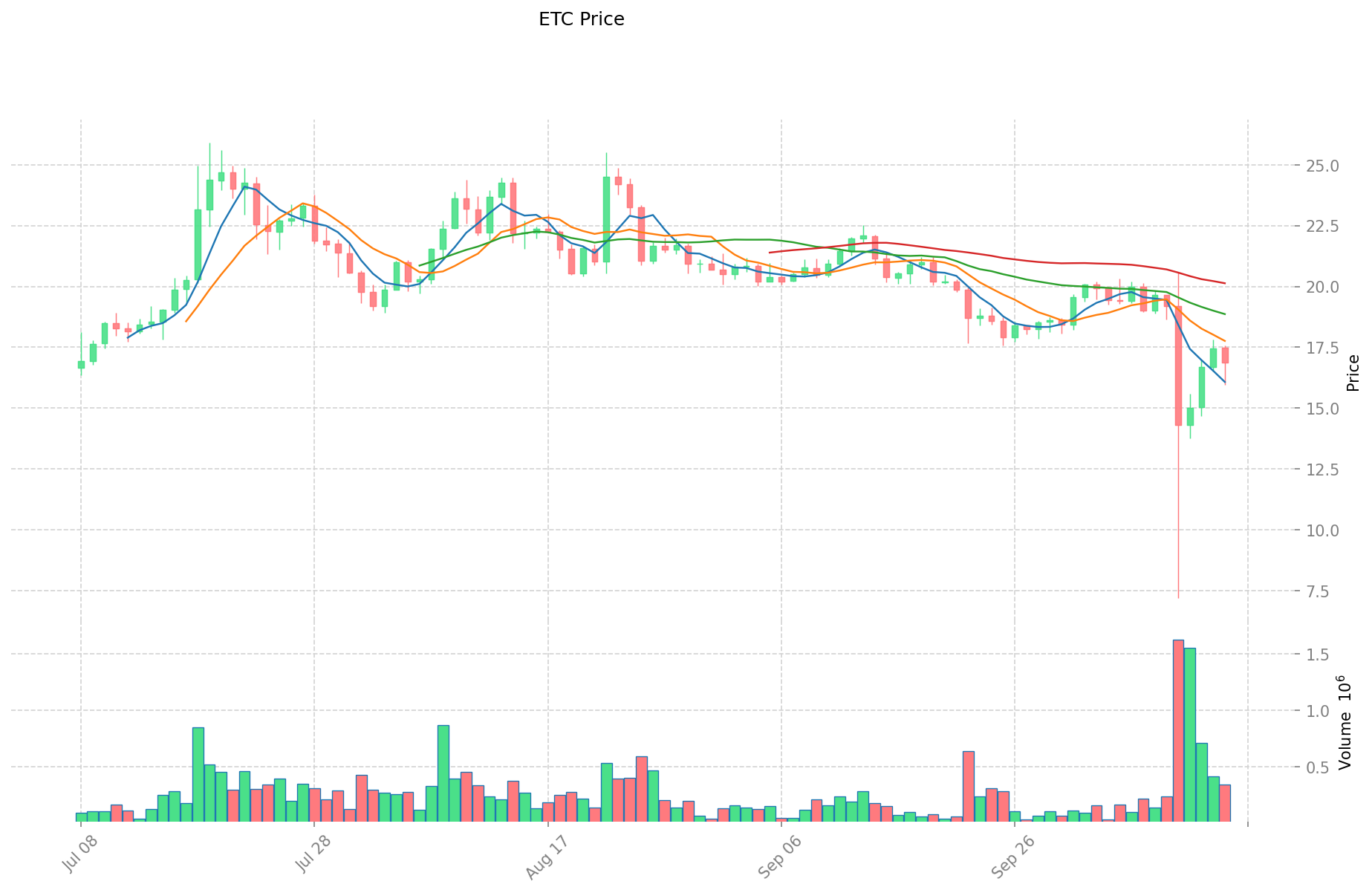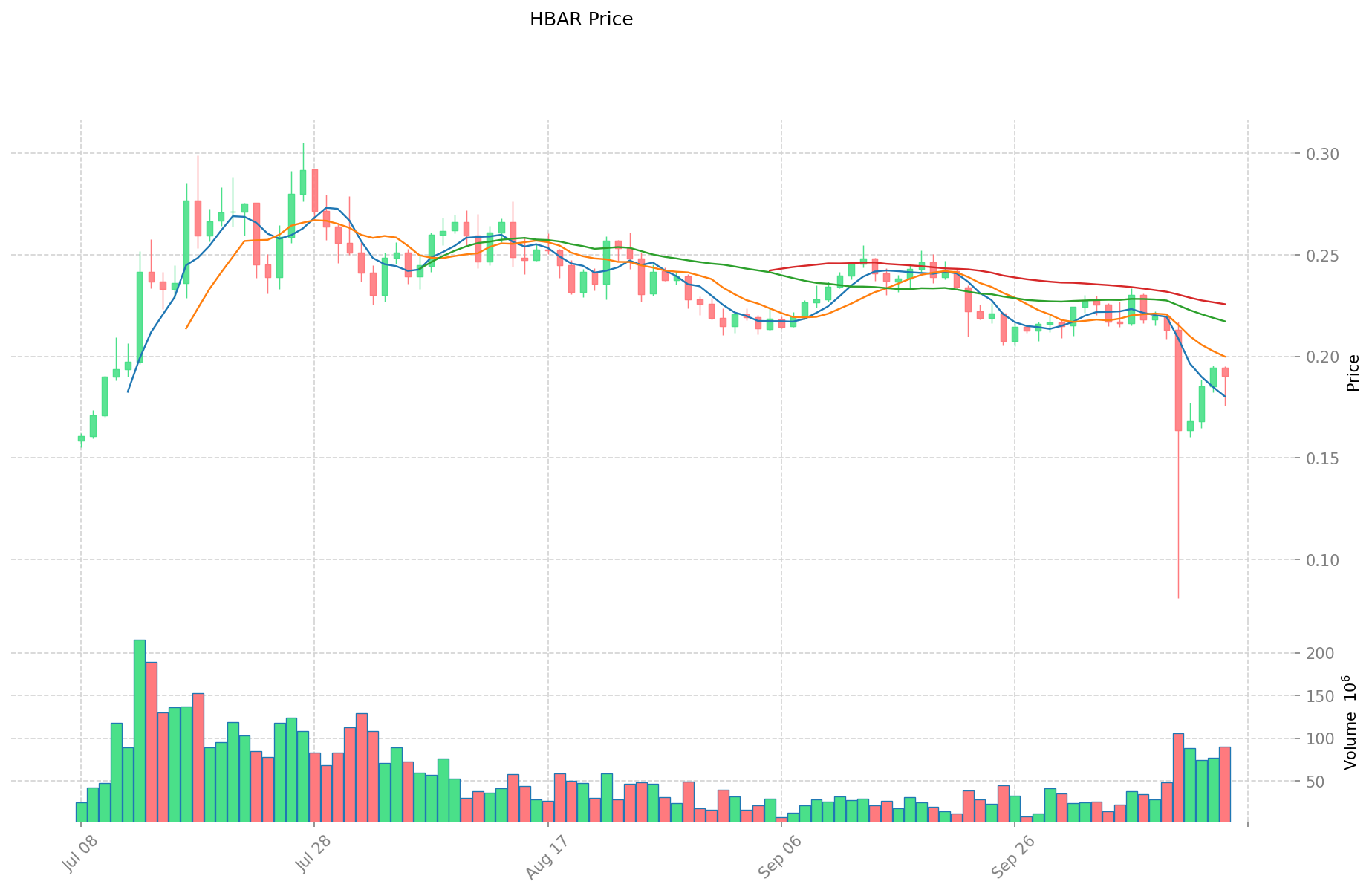ETC vs HBAR: Comparing the Investment Potential of Ethereum Classic and Hedera Hashgraph
Introduction: ETC vs HBAR Investment Comparison
In the cryptocurrency market, the comparison between Ethereum Classic (ETC) vs Hedera (HBAR) has always been a topic that investors can't avoid. The two not only differ significantly in market cap ranking, application scenarios, and price performance but also represent different cryptocurrency asset positioning.
Ethereum Classic (ETC): Since its launch in 2016, it has gained market recognition for its commitment to decentralized smart contract execution and the "code is law" principle.
Hedera (HBAR): Introduced in 2019, it has been hailed as a fast and secure public ledger network, utilizing hashgraph consensus to support distributed applications and micropayments.
This article will comprehensively analyze the investment value comparison between ETC and HBAR, focusing on historical price trends, supply mechanisms, institutional adoption, technological ecosystems, and future predictions, attempting to answer the question investors care about most:
"Which is the better buy right now?" Here is the analysis based on the provided template and data:
I. Price History Comparison and Current Market Status
Ethereum Classic (ETC) and Hedera (HBAR) Historical Price Trends
- 2020: ETC price dropped significantly due to multiple 51% attacks, falling from over $12 to under $5.
- 2021: HBAR saw major price growth, rising from $0.03 to an all-time high of $0.57 in September due to increased adoption and partnerships.
- Comparative analysis: During the 2022 bear market, ETC fell from its peak of $167.09 to a low of $13.35, while HBAR declined from $0.57 to around $0.04.
Current Market Situation (2025-10-15)
- ETC current price: $16.743
- HBAR current price: $0.18744
- 24-hour trading volume: ETC $5,733,896 vs HBAR $16,517,954
- Market Sentiment Index (Fear & Greed Index): 34 (Fear)
Click to view real-time prices:
- View ETC current price Market Price
- View HBAR current price Market Price


II. Core Factors Affecting Investment Value of ETC vs HBAR
Supply Mechanisms Comparison (Tokenomics)
- ETC: Fixed supply model similar to Bitcoin, with a maximum cap on total tokens
- HBAR: Pre-mined supply with controlled distribution through the Hedera Governing Council
- 📌 Historical Pattern: Fixed supply models like ETC's tend to create scarcity-driven price appreciation over time, while HBAR's controlled distribution aims to maintain price stability.
Institutional Adoption and Market Applications
- Institutional Holdings: HBAR appears to have stronger institutional backing through its Governing Council members
- Enterprise Adoption: HBAR shows potential for enterprise applications in supply chain management and decentralized identity solutions, while ETC focuses on decentralized finance applications
- Regulatory Attitudes: HBAR seems to have developed deeper cooperation with the US government, potentially offering regulatory advantages
Technical Development and Ecosystem Building
- ETC Technical Development: Maintains focus on decentralized finance and smart contract functionality
- HBAR Technical Development: Utilizes hashgraph consensus mechanism optimized for enterprise-grade blockchain applications
- Ecosystem Comparison: HBAR emphasizes enterprise solutions, while ETC's value proposition centers on decentralized finance and smart contracts
Macroeconomic Factors and Market Cycles
- Performance in Inflationary Environments: ETC's fixed supply model potentially offers better inflation resistance
- Geopolitical Factors: HBAR's enterprise and government partnerships may provide stability during market uncertainty
III. 2025-2030 Price Prediction: ETC vs HBAR
Short-term Forecast (2025)
- ETC: Conservative $10.19 - $16.71 | Optimistic $16.71 - $18.72
- HBAR: Conservative $0.17 - $0.19 | Optimistic $0.19 - $0.27
Mid-term Forecast (2027)
- ETC may enter a growth phase, with prices expected in the range of $16.10 - $24.25
- HBAR may enter an expansion phase, with prices expected in the range of $0.21 - $0.38
- Key drivers: Institutional capital inflow, ETF developments, ecosystem growth
Long-term Forecast (2030)
- ETC: Base scenario $16.87 - $25.56 | Optimistic scenario $25.56 - $38.08
- HBAR: Base scenario $0.32 - $0.43 | Optimistic scenario $0.43 - $0.44
Disclaimer: The above forecasts are based on historical data and market analysis. Cryptocurrency markets are highly volatile and unpredictable. This information should not be considered as financial advice. Always conduct your own research before making investment decisions.
ETC:
| 年份 | 预测最高价 | 预测平均价格 | 预测最低价 | 涨跌幅 |
|---|---|---|---|---|
| 2025 | 18.71744 | 16.712 | 10.19432 | 0 |
| 2026 | 24.0920192 | 17.71472 | 11.6917152 | 5 |
| 2027 | 24.247908736 | 20.9033696 | 16.095594592 | 24 |
| 2028 | 27.54227978496 | 22.575639168 | 18.28626772608 | 34 |
| 2029 | 26.0613178555392 | 25.05895947648 | 24.3071906921856 | 49 |
| 2030 | 38.084606612354304 | 25.5601386660096 | 16.869691519566336 | 52 |
HBAR:
| 年份 | 预测最高价 | 预测平均价格 | 预测最低价 | 涨跌幅 |
|---|---|---|---|---|
| 2025 | 0.2677389 | 0.18723 | 0.168507 | 0 |
| 2026 | 0.3162033855 | 0.22748445 | 0.195636627 | 21 |
| 2027 | 0.3832999240275 | 0.27184391775 | 0.2093198166675 | 45 |
| 2028 | 0.363604832186512 | 0.32757192088875 | 0.216197467786575 | 74 |
| 2029 | 0.51492668104107 | 0.345588376537631 | 0.297206003822362 | 84 |
| 2030 | 0.443165254653031 | 0.430257528789351 | 0.318390571304119 | 129 |
IV. Investment Strategy Comparison: ETC vs HBAR
Long-term vs Short-term Investment Strategies
- ETC: Suitable for investors focused on decentralized finance and smart contract applications
- HBAR: Suitable for investors interested in enterprise blockchain solutions and potential government partnerships
Risk Management and Asset Allocation
- Conservative investors: ETC: 30% vs HBAR: 70%
- Aggressive investors: ETC: 60% vs HBAR: 40%
- Hedging tools: Stablecoin allocation, options, cross-currency portfolio
V. Potential Risk Comparison
Market Risk
- ETC: Vulnerability to 51% attacks, historical security incidents
- HBAR: Centralization concerns due to Governing Council structure
Technical Risk
- ETC: Scalability issues, network stability concerns
- HBAR: Proprietary consensus mechanism, potential single points of failure
Regulatory Risk
- Global regulatory policies may have different impacts on both, with HBAR potentially having an advantage due to its enterprise and government partnerships
VI. Conclusion: Which Is the Better Buy?
📌 Investment Value Summary:
- ETC advantages: Fixed supply model, established presence in decentralized finance
- HBAR advantages: Enterprise adoption potential, fast and efficient consensus mechanism
✅ Investment Advice:
- New investors: Consider a balanced approach, leaning towards HBAR for its potential stability
- Experienced investors: Evaluate both based on risk tolerance and belief in respective ecosystems
- Institutional investors: HBAR may offer more alignment with traditional corporate governance structures
⚠️ Risk Warning: The cryptocurrency market is highly volatile. This article does not constitute investment advice. None
VII. FAQ
Q1: What are the main differences between ETC and HBAR? A: ETC is focused on decentralized finance and smart contracts with a fixed supply model, while HBAR is designed for enterprise blockchain solutions with a controlled distribution model. ETC uses a proof-of-work consensus mechanism, whereas HBAR utilizes a proprietary hashgraph consensus algorithm.
Q2: Which cryptocurrency has shown better price performance historically? A: Based on historical data, HBAR has shown more significant price growth, particularly in 2021 when it reached an all-time high of $0.57. However, both cryptocurrencies experienced substantial declines during the 2022 bear market.
Q3: How do the supply mechanisms of ETC and HBAR differ? A: ETC has a fixed supply model similar to Bitcoin, creating scarcity over time. HBAR has a pre-mined supply with controlled distribution through the Hedera Governing Council, aimed at maintaining price stability.
Q4: Which cryptocurrency appears to have stronger institutional backing? A: HBAR seems to have stronger institutional backing through its Governing Council members and partnerships with enterprises and government entities.
Q5: What are the key risks associated with investing in ETC and HBAR? A: For ETC, key risks include vulnerability to 51% attacks and historical security incidents. For HBAR, centralization concerns due to its Governing Council structure and reliance on a proprietary consensus mechanism are potential risks.
Q6: How do the long-term price predictions for ETC and HBAR compare? A: By 2030, ETC is predicted to reach $16.87 - $38.08 in various scenarios, while HBAR is forecast to reach $0.32 - $0.44. However, these predictions are speculative and should not be considered as financial advice.
Q7: Which cryptocurrency might be more suitable for different types of investors? A: New investors might consider a balanced approach leaning towards HBAR for its potential stability. Experienced investors should evaluate both based on their risk tolerance. Institutional investors may find HBAR more aligned with traditional corporate governance structures.